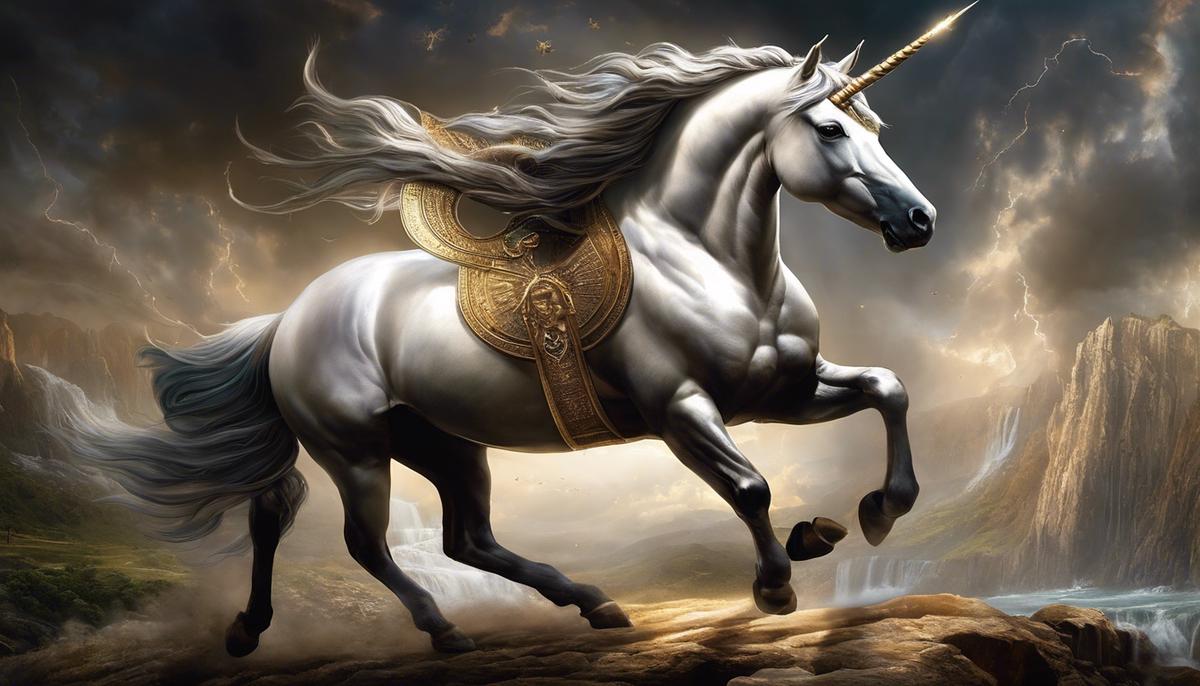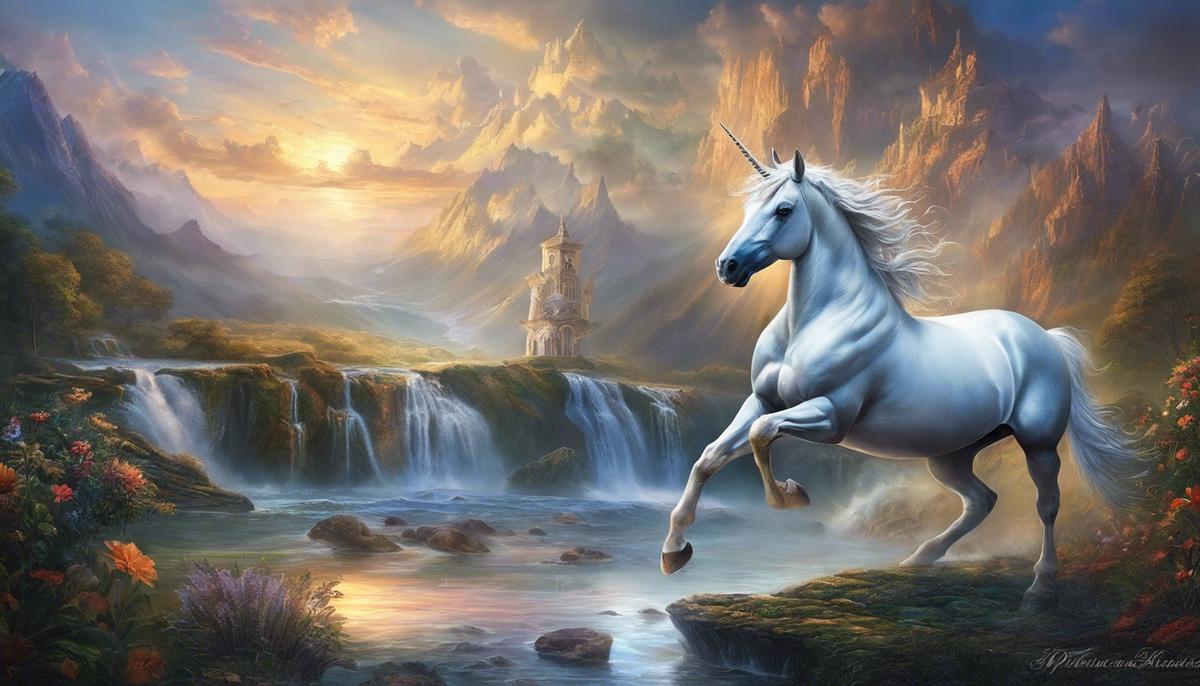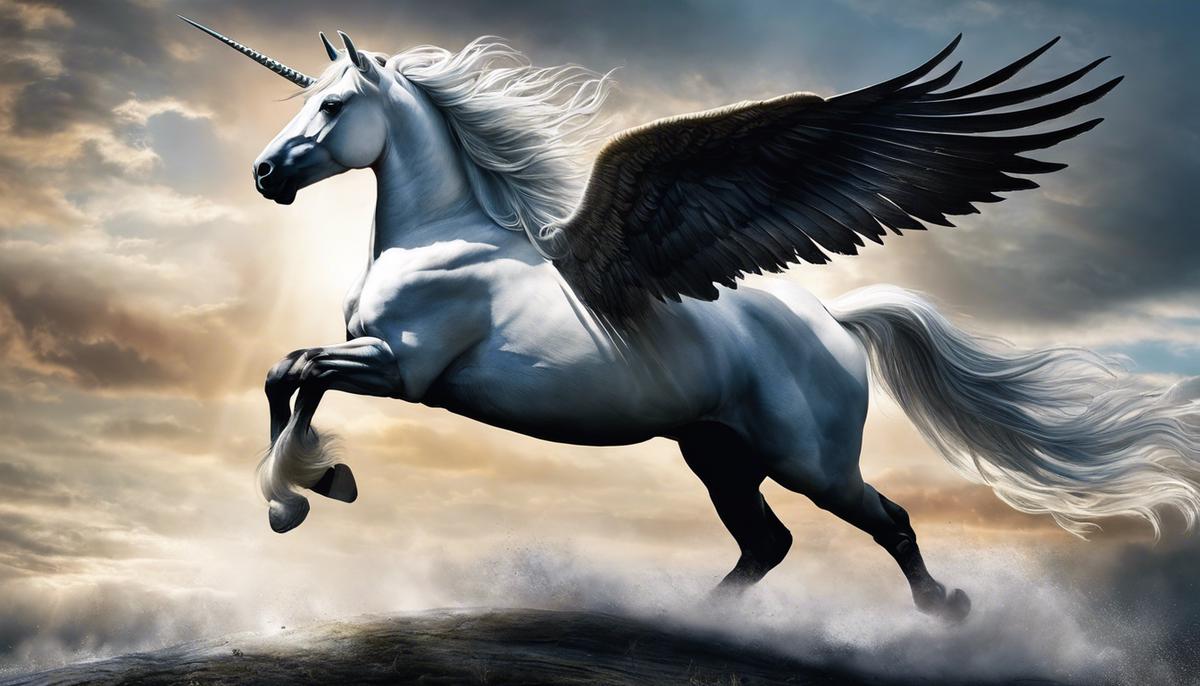In the multifaceted tapestry of biblical symbolism, each thread unveils a unique layer of understanding, setting the stage for conducive introspection. Our topic of focus, unicorns, known for their rarity and majestic connotations, command symbolic importance in the Holy texts. In the religious framework, these mythical creatures, often translated as ‘wild bull’ or ‘rhinoceros’, invite a plethora of interpretations, weaving intricate parallels with dream narratives. En route, we encounter theories from the realm of dream psychology and utilize biblical references as a medium to delve into these unconscious narratives. As we decipher this mystical creature’s symbol, we contrast its depiction in various belief structures, further deepening our understanding along multiple dimensions.
Biblical Symbolism of Unicorns
The Symbolism of Unicorns in Biblical Scriptures
Within the diverse expanse of biblical scriptures, animal symbolism plays a compelling role, subtly delivering vivid moral and spiritual teachings. One such animal that manifests prominently in biblical texts is the mythical creature we commonly refer to as the unicorn.
Historically, the unicorn has captivated human imagination with its quintessential attribute of singularity represented through the solitary horn. However, any reference to unicorns in the English Bible is indeed a recent phenomenon, one that arose from translation nuances. The original Hebrew text uses the term “re’em,” which is widely thought to portray an animal called an auroch – an extinct species of large wild cattle.
The introduction of the ‘unicorn’ in the English translation, notably in the King James Version, was due to the translator’s unfamiliarity with the auroch. Given the elusive and mysterious nature of the unicorn and the striking visual depiction of a solitary horn, it made an apt analog to embody the concepts of oneness, god’s sovereignty, ultimate power, and strength.
Unicorns in the scripture often serve as symbols for strength and power. We observe in Numbers 24:8 the statement, “God brought him forth out of Egypt; he hath, as it were, the strength of a unicorn.” Applying our interpretation, this expression invokes the imagery of an extraordinarily mighty, solitary, and unconquerable entity, paralleling Deity’s overriding strength and power.
Furthermore, unicorns symbolically represent an elusive desire for purity and sanctitude, an embodiment of mystifying, unattainable perfection in the face of earthly imperfections. In Job 39:10, when querying if one can bind the unicorn and plow the valleys, the biblical narrative subtly hints at humans’ inability to harness and control spiritual purity and divine strength, signifying our limitations in the face of spiritual enormity.
In essence, the enigmatic concept of the ‘unicorn’ in the Biblical text serves as an enduring symbol of god’s unsurpassable strength and sovereignty. While an anomaly in the wider realm of Biblical fauna, its presence, nevertheless, offers us intriguing insights into the vast symbolic contemplations embedded within these sacred scriptures. This unique narrative technique enriches the complexity of biblical interpretation, stimulating us to pursue constant engagement and deeper comprehension. As we navigate these texts, bound by the interplay of realism and symbolism, we unravel the essence of spiritual intellect in an ongoing exploration of faith and human understanding.

The Psychology of Dreams
With a deep-dive into unicorns and their symbolic representations as per the exegesis of Biblical scriptures behind us, let us now explore a sphere that is yet enigmatic- the mind’s subconscious labyrinthine and its manifestation in dreams.
The human mind -a compelling enigma, translucent as it is obscure- is a realm scientists have endeavored to fathom for centuries. Its epicenter has traditionally been believed to be the active, conscious mind. Yet, cloaked within the veiled catacombs of the subconscious, lie dreamscapes waiting to be unraveled. The subconscious mind intermittently catapults these dream schemes into the domain of our nocturnal cognition.
A question of paramount interest is, how does the subconscious mind create images, and what do these images mean? Thus, navigating this arcane bridge between the conscious and subconscious mind leads to dream analysis- an inescapable part of this discourse.
Renowned scholar, Sigmund Freud, committed decades to the study of dreams, pegging them as “the royal road to the unconscious.” Freud proposed that our subconscious tends to adopt symbolism in dreams to convey emotions or desires repressed in the conscious mind. This could potentially elucidate the recurrence of certain motifs (like unicorns) in dreams as symbols of strength, sanctitude, and purity that lie latent in the unconscious mind, yearning for expression.
Contemporary neuroscience corroborates Freud’s perspective, albeit with a twist. As per modern neural research, dreams are complex constructs of our subconscious mind, deriving their elements from our memories, fears, anticipations, and desires, weaving them into unique, individual narratives. Essentially, dreams result from the brain’s attempt to assimilate and consolidate experiential data uniquely specific to each individual.
As neuroscience advances towards the frontier of dreams, it becomes increasingly evident that dreams are more than mere passive byproducts of sleep. Specifically, they are critical in memory consolidation, processing emotions, learning, and creative problem solving. Thus, the physical processes entwined with dream formation overlap with much of the metaphorical symbolism that underpins our understanding of dreams from a Biblical perspective.
To conclude, the connection between the subconscious mind, its creation of images in dreams and their symbolic meanings, is a nuanced interplay of various physical, emotional, mental, and spiritual facets. It serves to remind us that, much like the symbolic unicorn, the human mind as a ‘monster of one horn,’ possessing singular, unparalleled strength and intricacy, is yet to be fully tamed or understood. It is an awe-inspiring testament to the boundless enormity and potential encapsulated within us, deserving of our respect, reverence, and continued exploration.

Interpreting Biblical Dream Symbols
Biblical symbolism, presently focused on the unicorn, creates an enchanting tapestry of the human experience. Coupled with the archetypal figures and storied landscapes, the subconscious mind utilizes these symbols in dreams to process empirical experiences. Indubitably, the human mind remains an enigma, cloaked in mystery and complex intricacy. It’s within dreams, the realm of the subconscious, where we further unlock this mystery and often encounter these potent biblical symbols.
Dream analysis, rooted in the pioneering work of Sigmund Freud, is a key method for interpreting such symbols. Freud postulated that dreams act as symbolic representations of repressed emotions or carnal desires, signifying a vast, labyrinthine network of thoughts and emotions. Upon dreaming, the subconscious mind liberates these repressed layers of the psyche, weaving them into the narrative of the dream. Here, symbols like the unicorn may act as conduits to represent various facets of the unconscious mind.
While Freud’s psychoanalysis formulated the initial understanding of dream theory, contemporary neuroscience has enriched and complicated our comprehension of the mysterious phenomena. Current neuroscience hypotheses suggest that dreams are more than mere constructs of the subconscious mind. Research indicates that dreams play a key role in cognitive functions such as memory consolidation, emotion processing, learning, and even problem-solving. As such, the appearance of biblical symbols like unicorns within dreams could potentially represent the interplay of these critical processes.
Furthermore, it is crucial to integrate a multilayered approach combining physical, emotional, mental, and spiritual facets in deciphering the symbolic meanings of dreams. Why the subconscious mind chooses specific symbols like the unicorn remains a puzzle to be solved. However, given the rich interplay of mental, emotional, spiritual and physical energies, we can infer that dream symbols offer multi-dimensional insights into our very beings.
In this fascinating intersection of neurobiology, psychology, and symbolism, we have a captivating glimpse into the extraordinary powers of the human mind. Undoubtedly, as our scientific understanding evolves, these dreams will offer even more astonishing perspectives into the roles of biblical symbols in narrative analysis. The analysis itself, a testament to the depth and breadth of the human experience, unveils what was once shrouded in mystery, offering the awe-inspiring potential of our consciousness and the profound intricacies of symbolic interpretation.

Comparative Analysis: Unicorns in different beliefs
Shifting our attention to the symbolism of the unicorn in other belief systems, it becomes apparent that unicorns have widespread significance across cultures and religions, their mythical presence accentuating spiritual narratives far beyond the biblical sphere. In Hinduism, unicorns occupy a potent space as a symbolism of purity and virtue. The ‘Ekasha Gaja’, akin to a unicorn, symbolized purity, signifying utmost spiritual ascencion, frequently associated with the divine couple Shiva and Parvati in Hindu mythos.
Moreover, in Chinese mythology, the Xiezhi, a unicorn-like creature, embodies justice and righteousness. It is seen as a divine beast, capable of discerning guilt and punishment, mirroring a version of the biblical unicorn’s strength and potency. Additionally, the Qilin, sometimes referred to as the ‘Chinese Unicorn’, carries connotations of benevolent gentleness alongside formidable power, further diversifying the utilization of unicorn symbolism.
In Celtic mythology, the Unicorn stands as a symbol of purity, innocence, masculinity, and power. A dichotomy exists here, comparing with the biblical interpretation. The fierceness and elusiveness found in biblical interpretation give way to connotations of purity and innocence within the Celtic context.
In Buddhist tradition, the unicorn, often depicted as a creature with a single horn, symbolizes peacefulness and tranquility, a stark contrast to the strength and power usually ascribed to it in biblical texts. This divergence might be thought to argue that the potent symbolism of the unicorn can be interpreted differently within varying cultural and religious paradigms.
Moving to the realm of dreams, the manifestation of unicorns denotes a reach towards the unattainable, a representation of goals and ideals that seem elusive. Building upon Freud’s theory of dreams as symbolic representations of repressed desires and contemporary neurobiology’s perspective of dreams as cognitive constructs, unicorns in dreams can translate into an individual’s longing for power, purity, or spiritual achievement.
Decoding the symbolism behind unicorns in dreams hence becomes an intriguing task. The complex interplay of cultural, psychological, and neurobiological factors leading the subconscious to adopt the symbol of the unicorn in dreams demonstrates the intricacies of inferential dream analysis. While mapping the symbol of the unicorn across different cultures drew contrasting representations, a singular fact emerged: the unicorn as a symbol transcends cultures and belief systems, largely signifying some form of power, purity, or spiritual significance, albeit colored differently in accordance to specific cultural paradigms.
Reflecting these parallels and contrasts, it becomes evident that while the unicorn carries a universally recognized symbol of power and purity, interpretations indeed vary immensely. The individual psyche’s interplay with cultural icons like unicorns elucidates the vast spectrum of influences shaping our subconscious. The symbolism, esoteric yet profoundly relatable, continues to intrigue researchers, unlocking the astonishing complexity and potential of the human mind. In the end, it’s clear that our understanding of such powerful symbols is not merely academic or scientifically driven, but profoundly human in its resonance, reflecting much about our collective spirit and individual aspirations.

Case Studies: Unicorn Dreams
Unicorns, regarded as remarkably majestic and magical creatures, have a rich history of symbolic importance across diverse cultures. Remarkably, they also have a strong symbolic presence in various religious and mythological traditions, including Hinduism, Chinese and Celtic mythology, and even Buddhism.
In Hindu mythology, the unicorn, represented as a white horse with a single horn, is believed to be a divine entity associated with truth and integrity. Simultaneously, Chinese legends portray the unicorn as an auspicious symbol of serenity, good fortune, prosperity, and grandeur. In Celtic mythology, the unicorn is revered as the embodiment of purity, innocence, masculinity, and power, whereas, in Buddhism, it is often interpreted as a bearer of good news and a symbol of spiritual enlightenment.
Dreams, albeit an enigma of the subconscious mind, often serve as a canvas for these symbolic representations to surface, offering profound insight into the dreamer’s psyche. Intriguingly, the emergence of unicorns in dreams paints a distinctive picture of symbolic connotations steered by individual, cultural, and spiritual leanings.
Interpreting unicorns in dreams is a nuanced, subjective process requiring a balanced understanding of cultural symbolism, psychological implications, and neurobiological perspectives on dreams. For instance, considering the significance of unicorns within the dreamer’s cultural scope plays a crucial role in the interpretation process. A culturally specific symbol, such as the unicorn, often carries inherent meanings shaped by shared beliefs, values, or experiences of the individual in context with the realm in which they exist.
Psychological research surrounding dream analysis reveals the role of repressed emotions and desires manifesting as symbols. Following Freud’s psychoanalytic perspective, the presence of a unicorn in dreams may signify suppressed longing for purity, sanctity, or desire for unattainable strength and power, consistent with biblical interpretations.
In contrast, contemporary neuroscientific findings contend that dream formations, facilitated by the subconscious mind, also involve memory consolidation, emotion regulation, and problem-solving processes. Therefore, dreaming of unicorns could also signify an ongoing cognitive process within the dreamer’s mind, perhaps signaling an attempt to reconcile a complex situation or navigate through emotional turmoil.
While cultural, psychological, and neurobiological parameters add unique dimensions to dream interpretation, they also emphasize the universality and variability of symbolic meanings attributed to unicorns. Regardless of the cultural backdrop, the symbolic spectrum of unicorns stretches from spiritual transcendence to worldly aspirations, and everything in between.
Pondering upon the symbolism of unicorns in various mythologies and their appearances in dreams is not merely an exercise in intellectual curiosity. It is an exploration into the labyrinthine depth of the human mind, its capacity for symbolism, and the enduring desire to seek meaning and purpose. Unicorns, in all their symbolic grandeur across cultures, reiterate the universality of this quest.
By analyzing the intricate tapestry of symbolism that unicorns represent within dreams, we can hope to better comprehend the breathtaking potentiality of the human mind and its ceaseless pursuit of understanding, meaning, and spiritual growth. Through this lens, we can appreciate the fascinating intersectionality of neurobiology, psychology, and symbolic meaning, underlining the dazzling complexity of human consciousness and its representation in the sublime spectacle of dreams.

Through this journey exploring unicorns and their significance as dream symbols, we have been witness to their representation across various belief systems and narratives. Through the careful scrutiny of their depiction across historical and contemporary perspectives and contexts, it is clear that these mystical creatures are more than simple projections of our subconscious. They inhabit a realm of symbolism that is grounded in ancient wisdom and modern psychoanalysis. The examination of multiple real-life dream scenarios reinforced their importance as powerful dream symbols. The dream symbolism of unicorns, therefore, serves as a mirror – a reflection of our deeper consciousness that encourages self-inquiry and introspection, unraveling profound insights masked in the guise of sleep.







